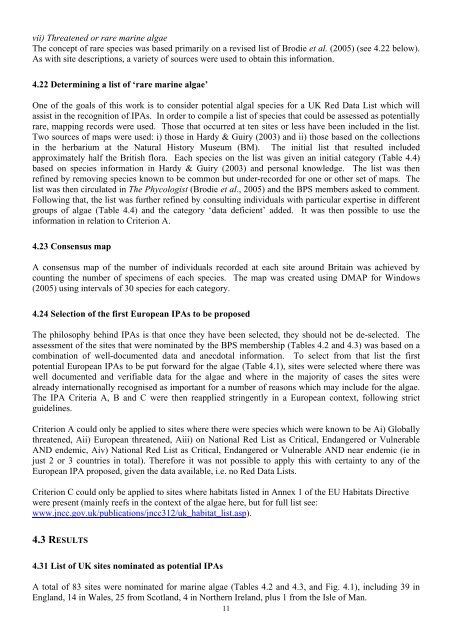Important Plant Areas for algae - Natural History Museum
Important Plant Areas for algae - Natural History Museum
Important Plant Areas for algae - Natural History Museum
You also want an ePaper? Increase the reach of your titles
YUMPU automatically turns print PDFs into web optimized ePapers that Google loves.
vii) Threatened or rare marine <strong>algae</strong><br />
The concept of rare species was based primarily on a revised list of Brodie et al. (2005) (see 4.22 below).<br />
As with site descriptions, a variety of sources were used to obtain this in<strong>for</strong>mation.<br />
4.22 Determining a list of ‘rare marine <strong>algae</strong>’<br />
One of the goals of this work is to consider potential algal species <strong>for</strong> a UK Red Data List which will<br />
assist in the recognition of IPAs. In order to compile a list of species that could be assessed as potentially<br />
rare, mapping records were used. Those that occurred at ten sites or less have been included in the list.<br />
Two sources of maps were used: i) those in Hardy & Guiry (2003) and ii) those based on the collections<br />
in the herbarium at the <strong>Natural</strong> <strong>History</strong> <strong>Museum</strong> (BM). The initial list that resulted included<br />
approximately half the British flora. Each species on the list was given an initial category (Table 4.4)<br />
based on species in<strong>for</strong>mation in Hardy & Guiry (2003) and personal knowledge. The list was then<br />
refined by removing species known to be common but under-recorded <strong>for</strong> one or other set of maps. The<br />
list was then circulated in The Phycologist (Brodie et al., 2005) and the BPS members asked to comment.<br />
Following that, the list was further refined by consulting individuals with particular expertise in different<br />
groups of <strong>algae</strong> (Table 4.4) and the category ‘data deficient’ added. It was then possible to use the<br />
in<strong>for</strong>mation in relation to Criterion A.<br />
4.23 Consensus map<br />
A consensus map of the number of individuals recorded at each site around Britain was achieved by<br />
counting the number of specimens of each species. The map was created using DMAP <strong>for</strong> Windows<br />
(2005) using intervals of 30 species <strong>for</strong> each category.<br />
4.24 Selection of the first European IPAs to be proposed<br />
The philosophy behind IPAs is that once they have been selected, they should not be de-selected. The<br />
assessment of the sites that were nominated by the BPS membership (Tables 4.2 and 4.3) was based on a<br />
combination of well-documented data and anecdotal in<strong>for</strong>mation. To select from that list the first<br />
potential European IPAs to be put <strong>for</strong>ward <strong>for</strong> the <strong>algae</strong> (Table 4.1), sites were selected where there was<br />
well documented and verifiable data <strong>for</strong> the <strong>algae</strong> and where in the majority of cases the sites were<br />
already internationally recognised as important <strong>for</strong> a number of reasons which may include <strong>for</strong> the <strong>algae</strong>.<br />
The IPA Criteria A, B and C were then reapplied stringently in a European context, following strict<br />
guidelines.<br />
Criterion A could only be applied to sites where there were species which were known to be Ai) Globally<br />
threatened, Aii) European threatened, Aiii) on National Red List as Critical, Endangered or Vulnerable<br />
AND endemic, Aiv) National Red List as Critical, Endangered or Vulnerable AND near endemic (ie in<br />
just 2 or 3 countries in total). There<strong>for</strong>e it was not possible to apply this with certainty to any of the<br />
European IPA proposed, given the data available, i.e. no Red Data Lists.<br />
Criterion C could only be applied to sites where habitats listed in Annex 1 of the EU Habitats Directive<br />
were present (mainly reefs in the context of the <strong>algae</strong> here, but <strong>for</strong> full list see:<br />
www.jncc.gov.uk/publications/jncc312/uk_habitat_list.asp).<br />
4.3 RESULTS<br />
4.31 List of UK sites nominated as potential IPAs<br />
A total of 83 sites were nominated <strong>for</strong> marine <strong>algae</strong> (Tables 4.2 and 4.3, and Fig. 4.1), including 39 in<br />
England, 14 in Wales, 25 from Scotland, 4 in Northern Ireland, plus 1 from the Isle of Man.<br />
11

















